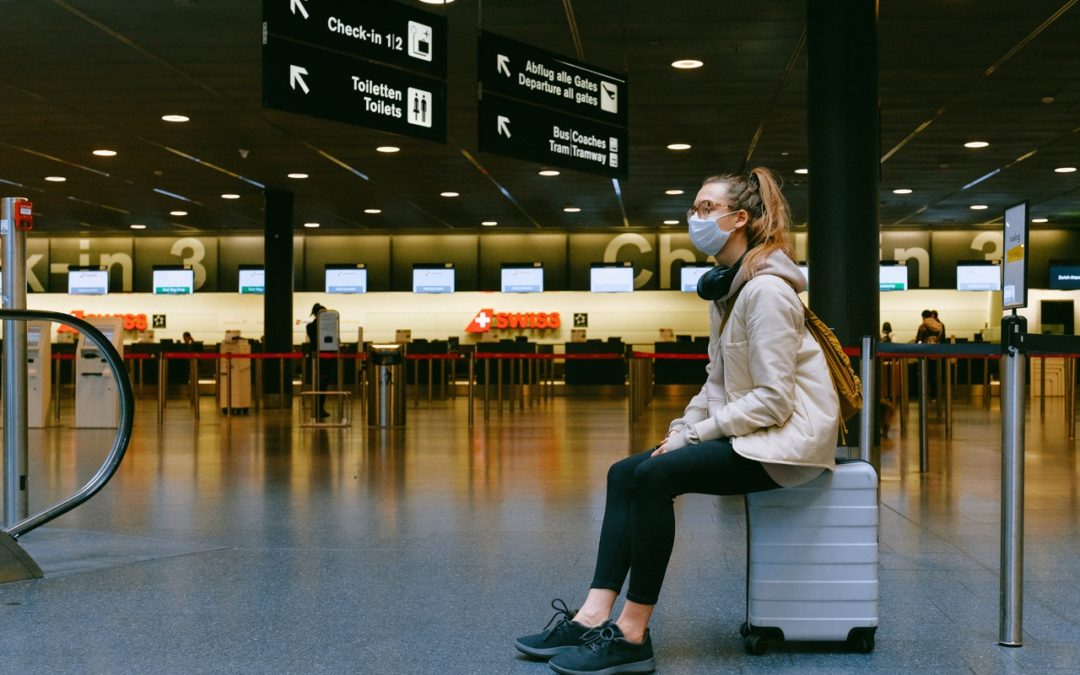If you have a trip planned soon, then you might wonder if it’s safe to travel now. Use this guide to learn all the coronavirus travel tips for a safe trip.
Anyone who’s left their house in the last few weeks, wherever you are in the world, has heard about the Coronavirus. COVID-19 is an infectious airborne pathogen that has spread from Wuhan, China, all the way around the globe. The process has taken only a month or two to sweep the globe and leave entire countries and communities in lockdown. This has halted a large portion of the way that humans are going about their lives. One of the issues that might be affecting people the most is the idea of travel. We may have had trips planned or want to go see our loved ones in these troubling times. We’re going to explore the idea of Coronavirus travel in this article, giving you some idea as to what you should and shouldn’t do when it comes to travel.
Coronavirus Travel: How to Stay Safe
 It’s important to take the severity of the situation into account and keep updated on how things are changing over time. If you’ve been paying close attention, you’ve noticed that whole communities have changed their way of life in the span of a few days. With that in mind, it’s important to base your travel plans off of the information currently being presented by the Center for Disease Control as well as the local government in the place you’re from and the place you plan to go. This is the very first thing you should consider when examining your travel plans. After you’ve got confirmation that the place you’re going isn’t going into quarantine or blocking travel, we’ve got a few other considerations for you to make before you start your trip. Rest assured, we’ll provide a few ways for you to remain safe when you do have to travel. But we’re going to pose a few ideas that may require some thought. Let’s take a look at the ideas you should consider when you’re deciding whether or not to make the trip.
It’s important to take the severity of the situation into account and keep updated on how things are changing over time. If you’ve been paying close attention, you’ve noticed that whole communities have changed their way of life in the span of a few days. With that in mind, it’s important to base your travel plans off of the information currently being presented by the Center for Disease Control as well as the local government in the place you’re from and the place you plan to go. This is the very first thing you should consider when examining your travel plans. After you’ve got confirmation that the place you’re going isn’t going into quarantine or blocking travel, we’ve got a few other considerations for you to make before you start your trip. Rest assured, we’ll provide a few ways for you to remain safe when you do have to travel. But we’re going to pose a few ideas that may require some thought. Let’s take a look at the ideas you should consider when you’re deciding whether or not to make the trip.
Essential vs Nonessential Travel
Currently, there are a number of places that the CDC has given a level 3 health notice. Level 1 health notices are given to let people know that there may be a health threat to watch out for. In those cases, people aren’t told to avoid travel, just be aware of the conditions. Level 2 notices suggest that all older people and individuals with chronic medical conditions avoid any nonessential travel. Level 3 threats suggest that all travelers avoid specific areas if the trip is not absolutely essential. In other words, the risk of sickness and spreading sickness likely outweighs the benefit of going in the first place. In times like these, it would be nice to have someone who could define “nonessential travel.” It would be nice to have someone make the decision for us and say, “no, you can’t travel for this reason. You have to stay at home.” It would be nice for no other reason than we wouldn’t have to make the decision ourselves. That said, “essential” isn’t given any definite terms in this case. It’s up to you to decide what needs to happen and what does not. If you have a sick family member who needs you, that should probably fall under “essential.” If you’re really trying to see what Cancun looks like when it’s totally empty, that doesn’t make the cut. There are a few things that can influence your decision, though. Let’s take a look at those.
1. The Classification of Your Destination
Currently, the CDC is monitoring the severity of the issue in the countries you might be looking to travel to. These ratings (1,2, or 3) should be a primary factor in your determination to travel or not. You should keep an eye on these classifications up until the day that you’re going to travel because things are changing so quickly. We mentioned it already, but remember that there wasn’t nearly as much concern for the coronavirus just a few weeks ago. Cases are spreading rapidly. Their effect is exponential when individuals aren’t self-isolating and quarantining. So, just because your destination looks good now doesn’t mean that things won’t change in the next week or two. So, if you find that the place you’re traveling to has a level 3 rating from the CDC, it might be a good idea to see if you can alter your plans until things settle down. As things currently stand, the CDC has suggested avoiding travel to China, Malaysia, South Korea, Iran, Most of Europe, the UK, and Ireland. If you enter these countries, or have entered them recently, you may not be able to return back to the United States.
2. Your Health and Age
The next thing that can determine how “essential” your travel is is your age and health. Those who have pre-existing conditions relating to the heart and lungs are at a much higher risk of dying from COVID-19. Illnesses like diabetes, COPD, or any other issue that indicates a compromised immune system should be considered serious deterrents from travel. Additionally, the older you are, the more likely it is that you should stay. Those who are over thirty show a progressively higher chance of being intensely affected by the disease. That said, individuals who are older than 60 are much more likely to die from the illness. Even with an excellent immune system, age seems to be a primary factor in whether or not people make it out of the hospital. If you’re young and healthy, there are also a few things to consider. First, know that your symptoms aren’t likely to show very much or at all. That said, you are still very contagious if you have it. That means that while you might feel great, other individuals around you might be more vulnerable to the illness.
3. The People You’re Visiting
If you’re planning to go on a trip to visit family or do business, consider the people you’ll be in most contact with. Remember the individuals described above who are most affected by the coronavirus. Ask if you’ll be in close contact with any of those demographics. Additionally, consider the people you don’t know as you’re moving through airports and communities abroad. There are ways you can reduce your impact, and we’ll discuss those soon. But remember that the disease is highly contagious. The ideas above should be taken into close consideration if you’re planning to travel and haven’t decided to go through with it. If you find that you have no choice but to travel, we’re going to go through some of the ways that you can do so safely. Let’s get started:
Traveling as Safely as Possible
If you’re going to travel, it’s important that you take a few precautions to be as safe as possible. Even if you’re not too worried about getting sick, it’s likely that others around us are immuno-compromised.
Avoid Public Gatherings
Vacations and business trips alike are typically peppered with visits to large public places. It’s likely that a lot of these potential places are closed down for the time being, but they may not be. It’s best to avoid situations that contain large groups of people in a confined area. Generally, you should try to keep your groups to a minimum of ten if you have to. Public squares, grocery stores, airports, train stations, and more should all be avoided if possible. It may be necessary to spend a little extra on transportation if you can, to avoid traveling on public transit. The point is, walk through your trip in your mind. Try to account for all of the places where you’ll potentially be surrounded by groups of people. Do your best to change these plans and accommodate for other solutions.
Travel Alone When You Can
Social distancing shouldn’t be forgotten. Even when you have to make the sacrifice to travel. It might be a good idea to contact a company for concierge and driving services to keep yourself alone while driving. Getting to and from an airport or hotel can put you into contact with a lot of people, particularly if you’re riding an airport shuttle or something similar. In these cases, it’s best to keep yourself and others safe by riding in an individual car. Further, you may have scheduled group trips or tours. On the off chance that these tours are still functioning as usual, make the change to do them alone or with your travel partner. While it’s nice to have the insight of a tour guide, it’s unwise to travel in groups in close proximity. Additionally, museums and cultural exhibits often prompt you to touch things. And look at them closely, which is a good way to expose yourself to the virus.
Change Your Destination if Possible
If the place you’re going is particularly affected by the virus, try and find a different area to go. Work with a team to change your reservations. See if you can get a refund. There are plenty of vacation options that won’t put you in as much danger. If you have to travel to meet someone for business, changing locations is still an option. If you have the resources to do so, it may be wise to front your business partner’s airfare. Meet them in a different locale. There are a lot of beautiful areas that aren’t as densely populated, giving them a far-smaller chance of getting you in contact with the virus. Sometimes, business meetings have to go through. It may not be worth it to have them in person if you or someone you’re around is immuno-compromised. Meetings can often take place over Skype or another video conferencing site. It’s not as if your meetings or vacations have to be canceled altogether. In all likelihood, the number of safe countries and communities will increase in the near future. You can suggest postponing meetings and get-togethers for the next few weeks if there’s any wiggle room. You might find that the person you’re working with feels the same about the virus and wants to self-isolate.
Get Tested Whenever You Can
If you’re planning on traveling, make an effort to get tested as often as you can and as much as your budget allows. Naturally, you should not continue to go around and commune with people if you find out that you’re sick. It’s wise to get tested before you leave the country, or make any further plans to do so. If you find that you’re clear of the virus now, do your due diligence and check for resources where you’re traveling. See if you can get tested after you arrive and periodically throughout your trip. There’s nothing wrong with getting checked often, and your company might even support and front your decision to do so. If you’re traveling alone, this small investment will be well worth the costs you would be faced with in medical bills. Not to mention, the potential cost of other people getting affected through your travels.
Additional Things to Consider
As you’re preparing for your trip, make sure that you make a mental note to be aware of how things are changing and keep updated on specific sources. Your Facebook or social media feeds will be one spot to look for changes that could affect you. That said, the information spread on those sites isn’t always the absolute most factual. While that doesn’t matter in all cases, this is a situation when you want to have updated and factual information. The Center for Disease Control’s website should be the first place you check on a day-to-day basis. Additionally, the state or country official websites will be a huge help with the most relevant information. These should be your most-viewed pages as it pertains to the coronavirus and how you can stay safe.
Need More Travel Information?
If you’re trying to learn more about coronavirus travel or traveling in general, we’re here to help. Explore our site for all of the information you need to have an enjoyable, safe trip.









